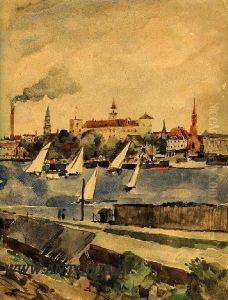Hermanis Grinbergs Paintings
Hermanis Grinbergs was a Latvian sculptor known for his significant contributions to Latvian art, particularly during the period between World War I and World War II, a time when Latvia experienced a brief period of independence between 1918 and 1940.
Born on December 17, 1893, in Riga, which at that time was part of the Russian Empire, Grinbergs displayed an early talent for art. His formal training began at the Riga City Art School, after which he continued his studies at the St. Petersburg Academy of Arts, one of the most prestigious art schools in the Russian Empire. There, he honed his skills in sculpting, which would become his primary medium of expression.
After World War I and the Russian Revolution, Grinberg returned to Latvia, which had declared independence from Russia in 1918. He became an active participant in the burgeoning Latvian art scene, contributing to the national identity and cultural life of the new nation. His works from this period often reflected the themes of Latvian folklore, national history, and the people's connection to their land.
During the 1920s and 1930s, Grinbergs produced numerous public monuments and busts of prominent Latvian figures. He was also a respected educator, teaching at the Latvian Academy of Arts and influencing a generation of young Latvian artists. His style was characterized by a blend of classical techniques with a more modern, simplified approach, reflecting the broader trends in European art of the time.
Hermanis Grinbergs' life and career were tragically cut short when he died on February 19, 1937. Despite his relatively short life, his legacy in Latvian art is enduring, with many of his works still on public display and his influence still felt in Latvian sculpture and art education. The political turmoil and subsequent Soviet occupation of Latvia during World War II led to a period of hardship for the country's artistic community, but Grinbergs' contributions helped lay the foundation for the Latvian art that would follow.
